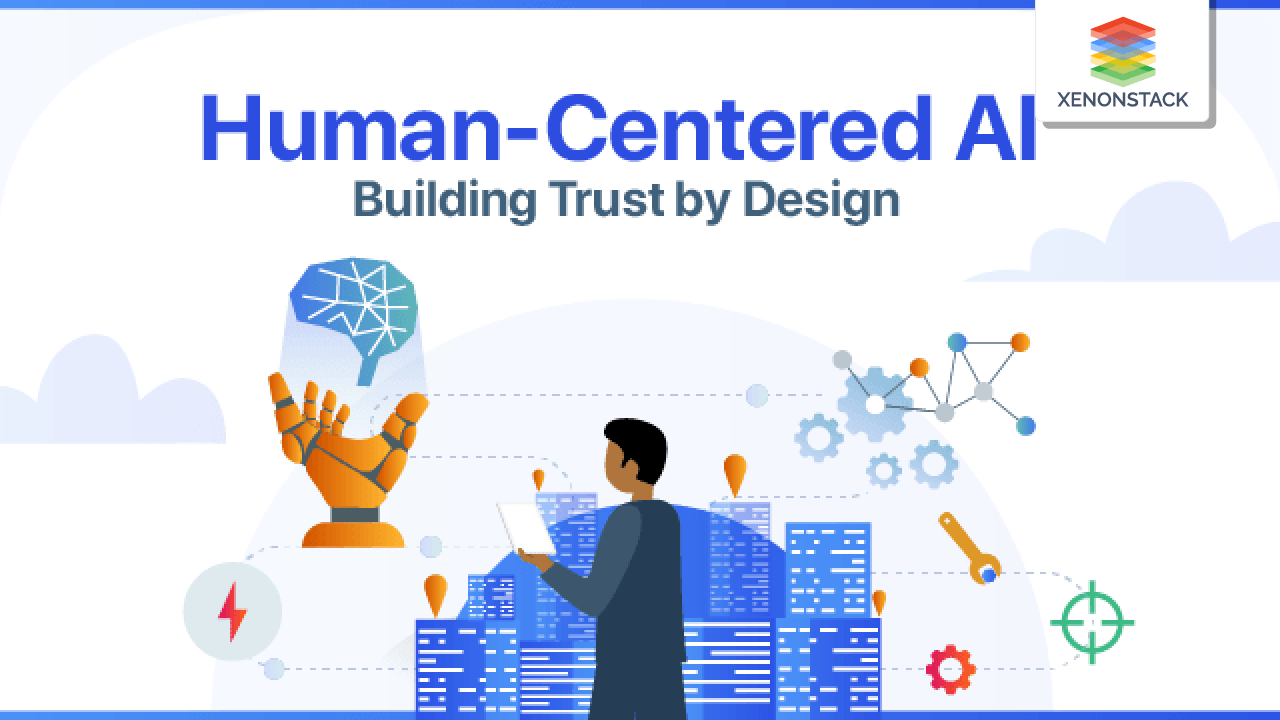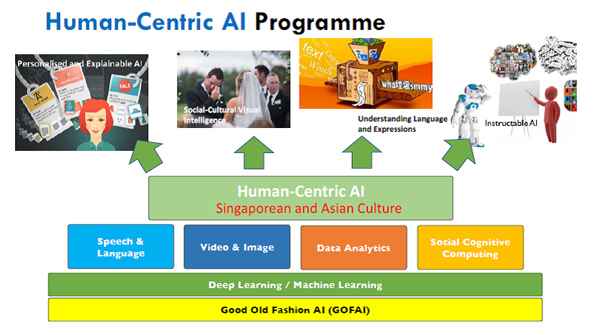User-First AI Innovation: Browsing the Digital Landscape with Human Centric AI
Wiki Article
Towards a Human-Centered AI Change: Redefining the Connection Between Human Beings and Intelligent Machines
In this paper, entitled "In the direction of a Human-Centered AI Change: Redefining the Connection Between Humans and Smart Equipments," we dig right into the current landscape of AI, exploring the honest considerations in its advancement. By equipping human-AI partnership and redefining the function of AI in culture, we aim to lay out a course towards an extra valuable and harmonious conjunction in between humans and smart makers.Understanding the Existing Landscape
The current landscape of human interaction with intelligent machines can be best comprehended through a detailed evaluation of existing AI applications and their influence on different industries. Expert System (AI) has swiftly arised as a transformative pressure throughout numerous fields, revolutionizing the way we live and function. From medical care and finance to transportation and production, AI applications have actually penetrated virtually every facet of our society.In medical care, AI-powered algorithms are being made use of to diagnose illness, predict client results, and even aid in surgical procedures. These technologies have the potential to significantly improve client care, lower medical mistakes, and improve total efficiency in healthcare delivery.
In financing, AI is transforming the means we make financial investment decisions, automate trading, and find deceitful activities. Artificial intelligence algorithms can analyze vast amounts of financial information in real-time, permitting for even more exact predictions and far better risk monitoring.
Transport is an additional location where AI is making substantial strides - human centric ai. Self-driving automobiles are coming true, with firms like Tesla and Waymo leading the way. AI-powered systems are making it possible for much safer and more reliable transport, decreasing crashes and traffic congestion
In manufacturing, AI is changing manufacturing procedures through making use of robotics and automation. Smart machines can carry out complicated jobs with accuracy and rate, causing increased efficiency and price savings.
These examples highlight the diverse range of AI applications and their effect on different markets. Understanding the existing landscape is crucial for individuals, businesses, and policymakers to harness the full possibility of AI while addressing its ethical, legal, and societal effects.
Moral Factors To Consider in AI Growth

An additional honest problem is the fairness and transparency of AI algorithms. AI systems frequently depend on large amounts of information to make choices, and if this data is prejudiced or insufficient, it can cause inequitable outcomes. Designers should guarantee that their algorithms are impartial and reasonable, and that they do not bolster existing predispositions in society.

Privacy is likewise a substantial honest factor to consider in AI advancement. AI systems often need access to personal information to function properly, yet this raises problems concerning data personal privacy and security. Developers need to carry out durable personal privacy actions and guarantee that individual data is protected and made use of responsibly.
Finally, there is an ethical duty to guarantee that AI systems are not utilized for harmful objectives. AI modern technologies have the potential to be made use of for security, cyberattacks, and various other harmful activities. It is essential for designers to prioritize the advancement of AI systems that are protected and resistant to misuse.
Humanizing AI: Empathy and Emotional Intelligence
To properly humanize AI, designers need to knowingly cultivate empathy and psychological knowledge in their smart makers. Empathy refers to the ability to recognize and share the feelings of others, while psychological knowledge includes the visit homepage ability to acknowledge, recognize, navigate to these guys and handle emotions, both in oneself and in others. Integrating these qualities into AI systems can significantly boost their capability to interact with human beings in a much more all-natural and purposeful method.By instilling empathy in AI, designers can create devices that can acknowledging and reacting to human feelings. This can be attained via the usage of all-natural language processing and belief evaluation techniques, enabling AI systems to recognize the psychological subtleties in human interaction. By precisely translating emotions, smart equipments can much better customize their responses, providing empathy and assistance when required.
Furthermore, emotional intelligence in AI can allow equipments to adjust their actions based upon the psychological state of the customer. An AI aide might acknowledge signs of aggravation or unhappiness in a user's voice and react with perseverance and compassion, using valuable ideas or words of motivation.
Developers can grow empathy and emotional knowledge in AI systems through using artificial intelligence algorithms. By educating AI designs on datasets that include psychological hints and responses, makers can learn to recognize and properly react to human emotions. In addition, ongoing study in affective computing and affective neuroscience can give important understandings into the growth of psychologically intelligent and understanding AI.
Equipping Human-AI Collaboration
Reliable cooperation between human beings and AI can be empowered with the critical integration of their corresponding toughness and capacities. The possibility of human-AI collaboration lies in using the one-of-a-kind abilities of both events to accomplish exceptional end results. People bring imagination, intuition, and contextual understanding, while AI brings computational power, data evaluation capabilities, and speed. By incorporating these toughness, we can produce a cooperative partnership where human beings and AI collaborate to fix complex issues, make educated choices, and drive innovation.To encourage human-AI collaboration, it is crucial to design AI systems that are straightforward, clear, and explainable. This implies developing intuitive user interfaces that facilitate smooth communication in between humans and AI algorithms (human centric ai). Additionally, AI designs ought to be transparent, providing individuals with understandings right into how decisions are made and allowing them to trust fund and validate the outputs
In addition, empowering human-AI collaboration needs recurring training and upskilling of human employees. This entails offering education and learning and sources that make it possible for people to understand and properly utilize AI systems. By empowering human beings with the knowledge and abilities to utilize AI's capabilities, we can make sure an unified collaboration that makes best use of the potential of both events.
Redefining the Duty of AI in Culture
The redefinition of the function of AI in culture necessitates a thoughtful and detailed evaluation of its effect and possibility. As AI technologies continue to advance and end up being much more incorporated right into numerous facets of our lives, it is essential to take into consideration just how they can best offer culture and address the difficulties we deal with.One element of redefining the role of AI in culture involves guaranteeing that it is made use of as a device to boost human capacities instead of change them. Joint approaches, where humans and AI interact, can bring about cutting-edge remedies and much better outcomes. This requires a change in frame of mind from viewing AI as a threat to embracing it as an important source that can support human ventures.
Another vital factor to consider is the honest use AI. As AI systems come to be much more capable and independent of making independent choices, questions emerge pertaining to transparency, justness, and accountability. It is vital to develop regulatory frameworks and honest standards to avoid the misuse of AI and make certain that it aligns with societal values.
In addition, the role of AI in dealing with social obstacles such as medical care, environment change, and destitution should be explored. AI redirected here has the potential to add dramatically to these locations by enabling better data evaluation, forecast designs, and targeted treatments.
Conclusion
Finally, the partnership between humans and intelligent devices is developing towards an extra human-centered AI transformation. The current landscape requires moral considerations in AI advancement to ensure liable and accountable usage. The humanization of AI, via empathy and psychological intelligence, can boost its ability to understand and react to human requirements. Equipping human-AI collaboration can lead to extra efficient and efficient end results. Ultimately, redefining the function of AI in culture can contribute to a future where people and smart machines interact for the betterment of society.In this paper, labelled "In the direction of a Human-Centered AI Revolution: Redefining the Relationship In Between Human Beings and Smart Machines," we delve into the existing landscape of AI, checking out the moral considerations in its advancement. By encouraging human-AI collaboration and redefining the duty of AI in culture, we intend to describe a path towards a more beneficial and unified coexistence between human beings and smart makers.

Report this wiki page